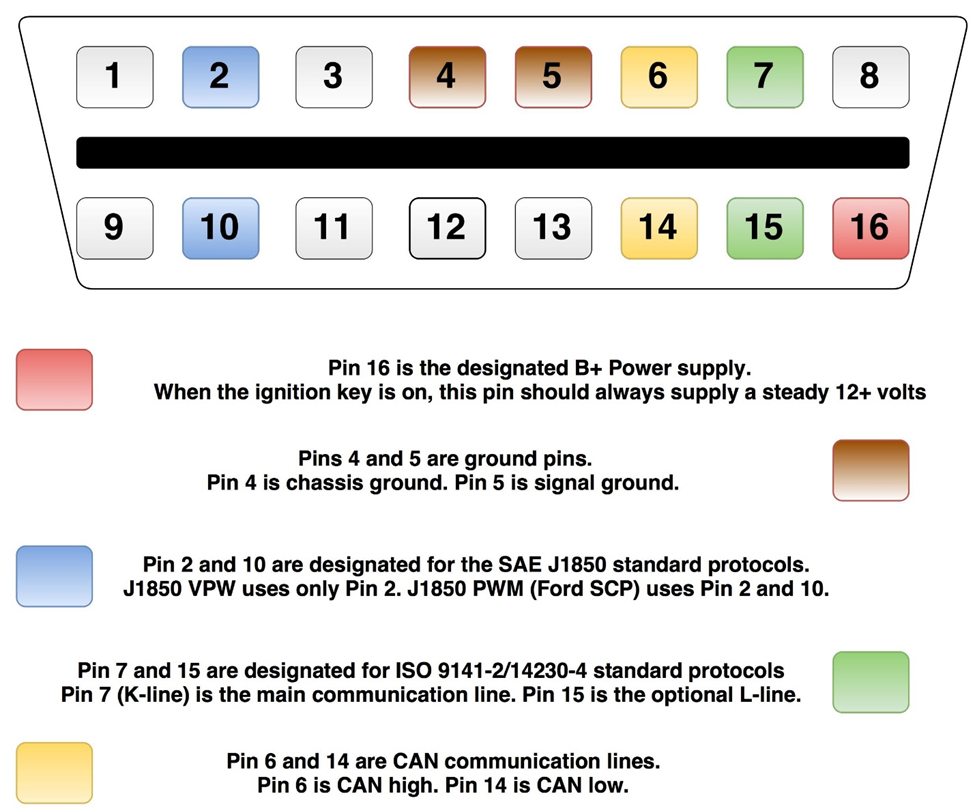OBD Communication
Problems:
Q: Inspection stations may encounter
vehicles that have problems communicating with the OBD inspection machine. What
should stations do to resolve these communication issues?
OBD communication issues can be caused by various
issues. Here are several common problems
to check for.
1.
Connector wiring issues
Every 1996+ vehicle certified to be sold in the United
States is OBD certified and uses a standardized connector (DLC) and connector
wiring. Different communication
protocols are used, but all protocols use the same pins to supply power and
ground to the emissions machine.
Pin 16 is the standard B+ power pin. Pin 4 and 5 supply ground for chassis and
signal ground. Check for 12+ volts
between pin 16 and each of these ground pins. You may want to load test the circuit by
connecting a test light as you measure the voltage.

The rest of the standard-designated pins are digital signal
pins of various protocol. Any non-designated pins may be used for manufacturer-specific
use but are not used for generic OBD communication.
** When checking the wiring at the DLC, it is easy to damage
the terminal pins. Do not spread the
terminal contacts by inserting test equipment that is too big, such as paper
clips or voltmeter leads. Only insert
test leads that are the correct size.
2. Communication interference
One possible cause of communication problems with off-board OBD devices such as
I/M inspection machines is a faulty module or network communication node
sharing the OBD network on the vehicle.

Generic OBD devices such as the I/M inspection machine communicate
with the necessary OBD module(s) through a communication network using one of
several communication protocols. In
general, several modules are connected to the OBD connector and communicate sharing
the same wire or wire pair. Any one
single module communication fault has the potential to affect the signal on the
entire network and disturb communication throughout all of the systems.
Some off-board devices are more sensitive to this
interference than others. This type of
fault may be found by checking secondary modules on the network for
communication problems or trouble codes using an OEM scan tool. Some aftermarket scantools supporting
manufacturer-specific modes may also have this capability in varying degrees.
On most vehicles, if you suspect a certain module is the
problem, you can disconnect the module from the network by unplugging the
module and seeing if the problem is resolved.
However, on some vehicles, network configuration or other issues caused
by disconnecting certain modules will make this diagnostic much more difficult
or impossible in some cases.
For a large amount of trouble vehicles, the problem will be
resolved by unplugging the ABS module.
The following makes are the most common with trouble ABS
modules:
·
AUDI
·
Volkswagen
·
Mitsubishi
·
Porsche
·
MAZDA
·
Subaru
Other vehicles may also have issues with the ABS
module. On most vehicles, it is a fairly
quick and easy diagnostic step to unplug the ABS module and see if the problem
is resolved.
Other known module issues include:
·
Select 2002 Ford Explorers have a communication
issue caused by the instrument cluster module.
If you encounter this issue, unplug fuse 2.21 5A (instrument cluster)
located in the central junction box under the dash and attempt the OBD
inspection while the fuse is unplugged.
·
Select 1997-1998 Porsche Boxster vehicles have a
communication issue that may be caused by the Transmission Control Module.
Unplug the “Tiptronic” TCM, located in the trunk and attempt the OBD test.
3. Aftermarket Accessories
Certain aftermarket installs can be tied to the OBD network
and cause inadvertent OBD communication problems. Remote start modules, aftermarket remote lock
modules, Vehicle GPS tracking modules, alarms, etc. can be tied into the OBD
system under the dash, under the hood, near the fuse box, or potentially
anywhere the wiring harness runs throughout the vehicle. These devices most often affect GM product
vehicles, but will potentially affect any make and model. Look under the dash, under the hood, near the
fuse box, and all along the wiring harness to locate any aftermarket wiring
harness or module. If any of these types
of aftermarket accessories are found, uninstallation of device and repair of
any related wiring is recommended to assure proper function of OBD and other systems. If an aftermarket radio is installed, it may
cause OBD issues on some vehicles if the wiring harness was not modified
correctly. To diagnose issues related to
aftermarket installs, disconnect device, ensure wiring is correct and not
damaged, and try OBD test while disconnected.
4. OBD-Related Emissions Recalls
From time to time manufacturers make mistakes when
implementing OBD protocols and certain cars need to be recalled to fix OBD
communication issues. Several BMW
vehicles have been a part of this type of recall, as well as other various
makes and models. To check for these
recalls, check the www.obdclearinghouse.com
OEM Database and input the vehicle information.
If a recall has been issued, a document will be stored in that database
for reference.